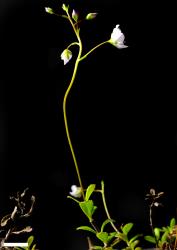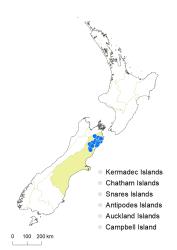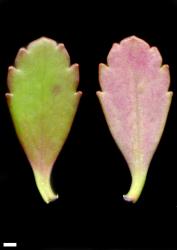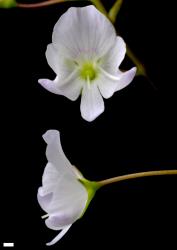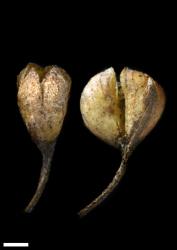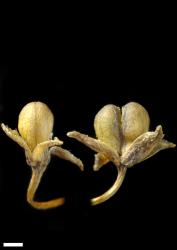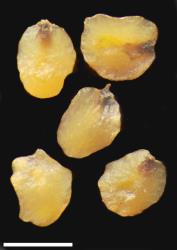- ≡ Parahebe catarractae subsp. martinii Garn.-Jones in Garnock-Jones & Langer, New Zealand J. Bot. 18: 295 (1980)
- ≡ Parahebe martinii (Garn.-Jones) Garn.-Jones in Garnock-Jones & Lloyd, New Zealand J. Bot. 42: 217 (2004)
Sprawling sub-shrub to 0.25 m tall. Stems prostrate to decumbent, eglandular-pubescent or glabrous; hairs bifarious. Leaf bud indistinct; leaves separating while very small, sub-distichous, spreading to reflexed; lamina sub-coriaceous, oblanceolate or obovate, sometimes elliptic, 5–35 mm long, 2–15 mm wide, glossy to somewhat dull green above, dull pale green beneath; midrib evident at least near base; surfaces with eglandular hairs along midrib above; margin glabrous, serrate; teeth in 3–5 (rarely 1–2) pairs; apex sub-acute, obtuse, or rounded; base cuneate; petiole 1–4 mm long. Inflorescence a lateral raceme, 70–120 mm long; flowers distant, 6–30, all bisexual; bracts alternate, linear to lanceolate, < pedicels; pedicels erecto-patent, incurved at fruiting, 6–17 mm long, glabrous or eglandular- rarely glandular-hairy all around. Calyx lobes usually 4, rarely 5, sub-acute to acuminate, 3–4 mm long, sub-equal, glabrous or glandular-ciliate. Corolla 7–13 mm diameter; tube white and yellow, 1.0–1.5 mm long, < calyx, eglandular-hairy inside; lobes 4, white or tinged pale purple, spreading, unequal, elliptic to obovate to orbicular, 3–6 mm long, rounded; nectar guides magenta or pink. Stamen filaments white, 3.5–4.0 mm long; anthers pink or purplish. Style glabrous, 3–5 mm long. Capsules angustiseptate, emarginate to didymous, glabrous, 3.0–4.3 mm long, 3–4 mm at widest point. Seeds ellipsoid or discoid, flattened, smooth, pale to dark brown, 0.7–1.2 mm long.
The sprawling habit, dark purplish- or reddish-black stems contrasting with the green petioles, narrow anterior corolla lobes, and glabrous or glandular inflorescences distinguish plants of V. melanocaulon from other speedwell hebes that have plicate corolla lobes and nectar guides. In this group, V. melanocaulon plants are most similar to some prostrate forms of V. lanceolata, which, however, are found in the North Island.
South Island: Marlborough, Canterbury (Seaward Kaikōura Mountains from Waimā River to Mt Terako and Mason River; Inland Kaikōura Mountains; Wairau Mountains at Spray River).
Gorges and rocky river and stream banks and cliffs on limestone and greywacke, usually shaded. Recorded elevations range from 100 to 930 m.
Flowers: November–April; fruits: December–April, probably persisting later.
2n = 42 (Garnock-Jones & Langer 1980, as Parahebe catarractae subsp. martinii).
Veronica melanocaulon is classified in V. subg. Pseudoveronica sect. Hebe (Albach & Meudt 2010). Molecular studies (Albach & Meudt 2010) and morphology place V. melanocaulon firmly among the “speedwell hebes”, such as V. lanceolata, V. catarractae, and V. lyallii.



